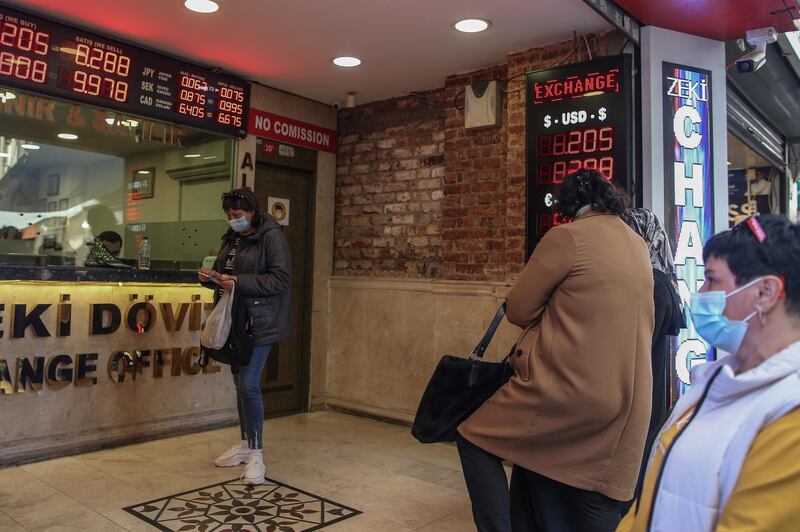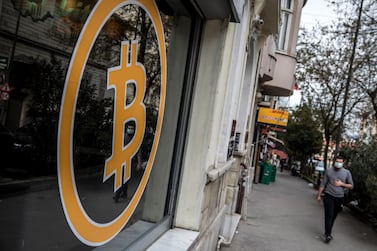The Turkish lira continued its rebound on Tuesday following a sell-off last week that led to the currency approaching record lows against the US dollar.
The lira was trading at 8.2237 to the dollar at 1.52pm UAE time on Tuesday, up 0.7 per cent on the day. However, this was after a slide of 3.9 per cent last week and the currency remains about 9.6 per cent lower year to date.
Last week's slide was the result of the "new central bank governor [Sahap] Kavcioglu’s endorsement of President Erdogan’s justification for the use of foreign reserves to defend the currency over the last year", Hasnain Malik, a Dubai-based emerging and frontier markets equity analyst at Tellimer, said.
"Also, [President] Biden's recognition of the Armenian genocide is a reminder of the potential for US sanctions in the context of less friendly relations."
Mr Kavcioglu was appointed last month after Mr Erdogan fired former governor Naci Agbal, who had stabilised the lira by hiking interest rates by 875 basis points to 19 per cent, the highest of any major economy in the world, in a bid to curb double-digit inflation.
Mr Agbal was the third central bank governor to be dismissed by Mr Erdogan since July 2019.
Previous central bank governors had sold foreign exchange [FX] reserves rather than raise interest rates, which Mr Erdogan opposes.
Turkey has used $165 billion of FX reserves to defend the lira over the past two years and that the country will do so again if needed, Mr Erdogan said last week, according to Bloomberg.
In a state TV interview on Friday, Mr Kavcioglu said the sales helped Turkey to steer through the pandemic.
The central bank's usable reserves [discounting reserves held to cover resident FX deposits] has fallen "to almost zero from the 2019 level of $47bn, equivalent to about 6 per cent of GDP", S&P Global said last month.
In the week after Mr Agbal's dismissal, the amount of FX reserves in Turkey fell by 63.9bn Turkish lira ($7.68bn), the Institute of International Finance's chief economist Robin Brooks said on Twitter on Sunday.
In the week following Turkey's sudden stop on Aug. 10, 2018, FX deposits fell TRY -38.5 bn. In the week after former CBRT Governor Agbal's dismissal on March 19, 2021, FX deposits fell TRY -63.9 bn. Seen through this lens, the Agbal shock was almost twice as big as the 2018 shock pic.twitter.com/EgCAd46hPT
— Robin Brooks (@RobinBrooksIIF) April 25, 2021
Turkish authorities may be keen to cut interest rates, but with inflation climbing above 16 per cent last month the country will need to maintain its policy rate above this level to retain foreign capital, Mr Malik said.
"It is unlikely they can [cut rates] in an orderly manner in the next few months. But over the next 12 months expectations are for inflation to fall and no doubt they will then seize the opportunity."
The dovish noises coming from the central bank suggests interest rate cuts are in the pipeline, Scott Livermore, chief economist at Oxford Economics, said.
"We see modest easing [in the second half of 2020] but the risk of early/sharper cuts is meaningful," he said.
"Turkey’s net reserve position is negative at around -$60bn and any attempts at intervention erode this further."
Turkey's reserves are already much lower than the country's external financing needs over the next year, Jason Tuvey, a senior emerging markets analyst at Capital Economics, said.
"A further ratcheting up of geopolitical tensions and/or concerns about the direction of policymaking in Turkey could cause the lira to come under severe pressure."
This would make it difficult to meet Mr Erdogan's call for lower rates and pressure could instead build to tighten rates.
"But we suspect that the next port of call would actually be capital controls and import restrictions," Mr Tuvey said.








